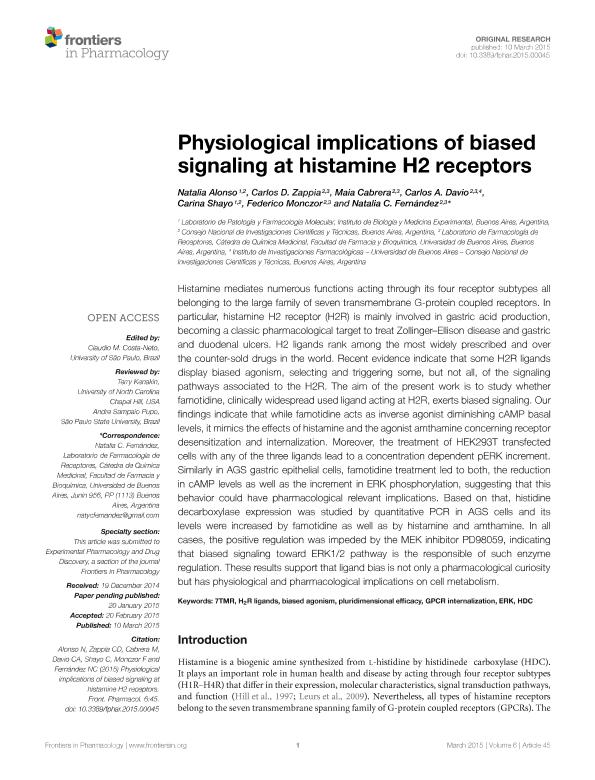Artículo
Physiological implications of biased signaling at histamine H2 receptors
Alonso, Natalia; Zappia, Carlos Daniel ; Cabrera, Maia Diana Eliana
; Cabrera, Maia Diana Eliana ; Davio, Carlos Alberto
; Davio, Carlos Alberto ; Shayo, Carina Claudia
; Shayo, Carina Claudia ; Monczor, Federico
; Monczor, Federico ; Fernandez, Natalia Cristina
; Fernandez, Natalia Cristina
 ; Cabrera, Maia Diana Eliana
; Cabrera, Maia Diana Eliana ; Davio, Carlos Alberto
; Davio, Carlos Alberto ; Shayo, Carina Claudia
; Shayo, Carina Claudia ; Monczor, Federico
; Monczor, Federico ; Fernandez, Natalia Cristina
; Fernandez, Natalia Cristina
Fecha de publicación:
03/2015
Editorial:
Frontiers
Revista:
Frontiers in Pharmacology
e-ISSN:
1663-9812
Idioma:
Inglés
Tipo de recurso:
Artículo publicado
Clasificación temática:
Resumen
Histamine mediates numerous functions acting through its four receptor subtypes all belonging to the large family of seven transmembrane G-protein coupled receptors. In particular, histamine H2 receptor (H2R) is mainly involved in gastric acid production, becoming a classic pharmacological target to treat Zollinger–Ellison disease and gastric and duodenal ulcers. H2 ligands rank among the most widely prescribed and over the counter-sold drugs in the world. Recent evidence indicate that some H2R ligands display biased agonism, selecting and triggering some, but not all, of the signaling pathways associated to the H2R. The aim of the present work is to study whether famotidine, clinically widespread used ligand acting at H2R, exerts biased signaling. Our findings indicate that while famotidine acts as inverse agonist diminishing cAMP basal levels, it mimics the effects of histamine and the agonist amthamine concerning receptor desensitization and internalization. Moreover, the treatment of HEK293T transfected cells with any of the three ligands lead to a concentration dependent pERK increment. Similarly in AGS gastric epithelial cells, famotidine treatment led to both, the reduction in cAMP levels as well as the increment in ERK phosphorylation, suggesting that this behavior could have pharmacological relevant implications. Based on that, histidine decarboxylase expression was studied by quantitative PCR in AGS cells and its levels were increased by famotidine as well as by histamine and amthamine. In all cases, the positive regulation was impeded by the MEK inhibitor PD98059, indicating that biased signaling toward ERK1/2 pathway is the responsible of such enzyme regulation. These results support that ligand bias is not only a pharmacological curiosity but has physiological and pharmacological implications on cell metabolism.
Archivos asociados
Licencia
Identificadores
Colecciones
Articulos(IBYME)
Articulos de INST.DE BIOLOGIA Y MEDICINA EXPERIMENTAL (I)
Articulos de INST.DE BIOLOGIA Y MEDICINA EXPERIMENTAL (I)
Articulos(ININFA)
Articulos de INST.DE INVEST.FARMACOLOGICAS (I)
Articulos de INST.DE INVEST.FARMACOLOGICAS (I)
Articulos(SEDE CENTRAL)
Articulos de SEDE CENTRAL
Articulos de SEDE CENTRAL
Citación
Alonso, Natalia; Zappia, Carlos Daniel; Cabrera, Maia Diana Eliana; Davio, Carlos Alberto; Shayo, Carina Claudia; et al.; Physiological implications of biased signaling at histamine H2 receptors; Frontiers; Frontiers in Pharmacology; 6; 3-2015; 1-9; 45
Compartir
Altmétricas



